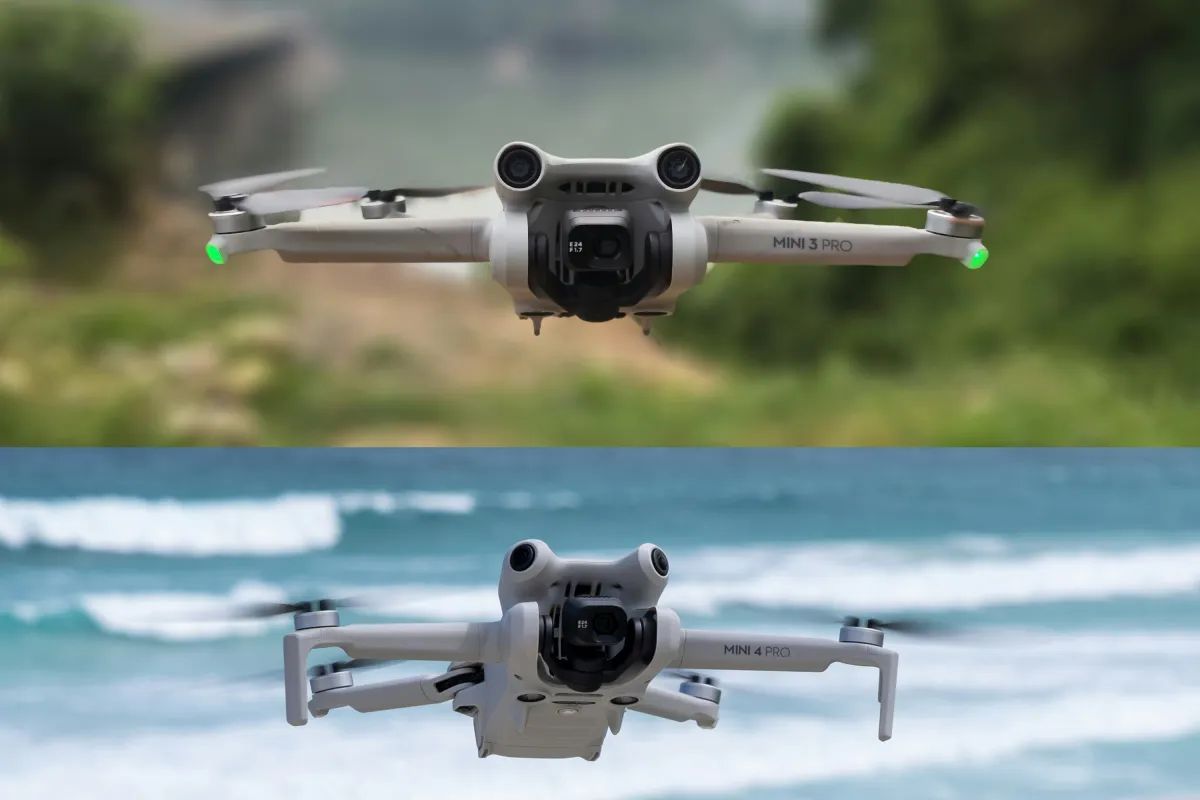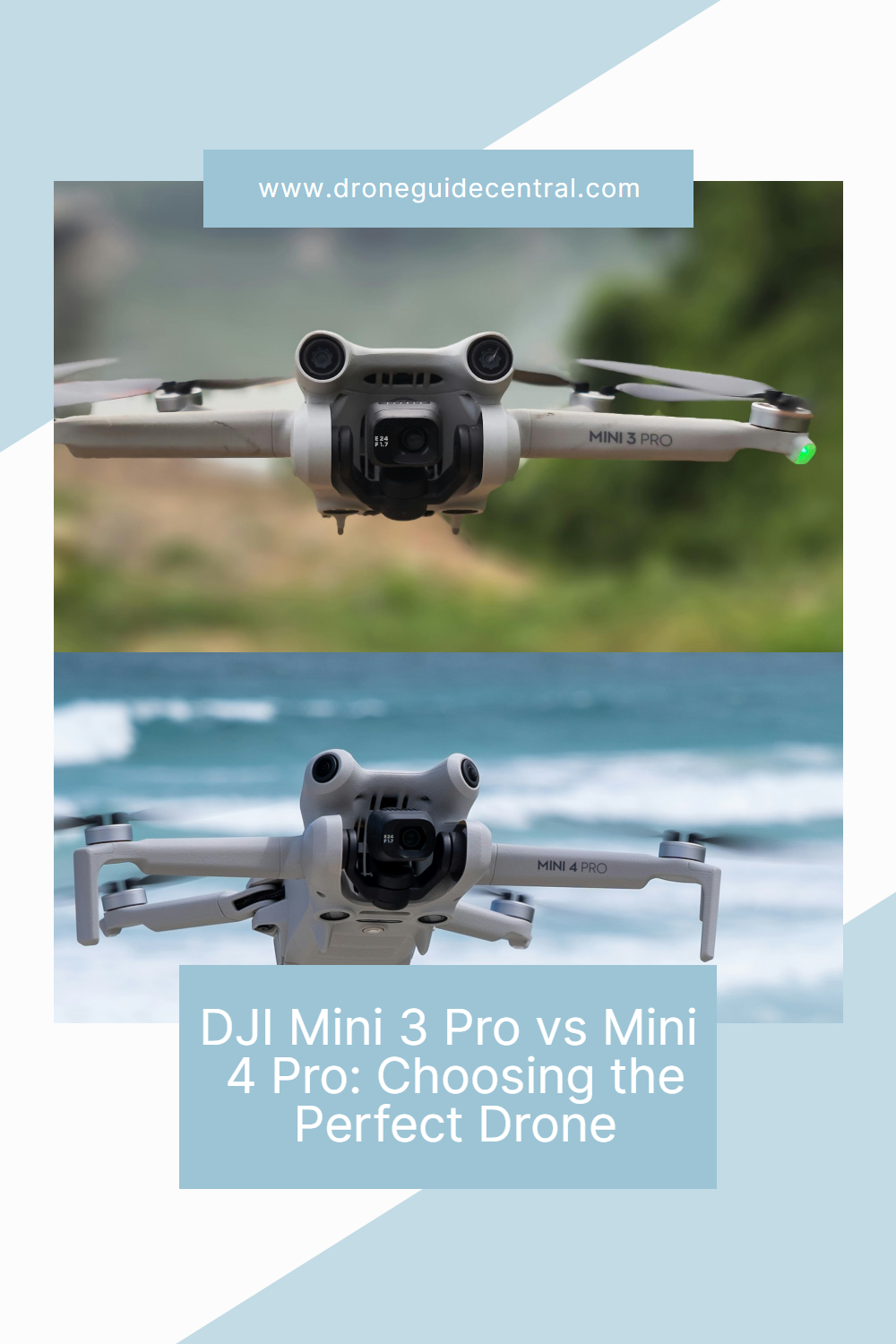
DJI Mini 3 Pro vs Mini 4 Pro: Choosing the Perfect Drone
In the realm of aerial photography and videography, DJI drones stand tall as reliable, feature-rich options. Today, I'll be diving into the comparison between two popular models: the DJI Mini 3 Pro vs Mini 4 Pro. I aim to provide you with insightful suggestions and reasons to help you make the right choice for your needs.
Introduction: DJI Mini 3 Pro vs Mini 4 Pro
Introducing two formidable contenders in the drone market: the DJI Mini 3 Pro and Mini 4 Pro. These compact yet powerful drones pack a punch in terms of performance and features, catering to both novice flyers and seasoned professionals. With the drone market evolving rapidly, it's crucial to understand the nuances between these two models to make an informed decision.
Design and Portability
When it comes to drones, portability is often a significant factor for users who value convenience and ease of transport. Both the DJI Mini 3 Pro and Mini 4 Pro excel in this aspect, featuring foldable designs that make them compact and travel-friendly.
The DJI Mini 3 Pro boasts slightly smaller dimensions when folded compared to the Mini 4 Pro, measuring 5.71 × 3.54 × 2.44 inches (145 × 90 × 62 mm) versus 5.82 × 3.7 × 2.52 inches (148 × 94 × 64 mm), respectively. Additionally, both of these drones weigh under 8.7 ounces (249 grams), making them exempt from certain aviation regulations in many countries.
Camera Specifications: DJI Mini 3 Pro vs Mini 4 Pro
A drone's camera serves as its primary visual tool, and both the Mini 3 Pro and Mini 4 Pro offer remarkable imaging capabilities. Equipped with identical 1/1.3-inch CMOS sensors boasting 48 MP resolution, both drones deliver exceptional image quality. However, the Mini 4 Pro introduces enhancements in slow-motion capabilities, supporting up to 4K resolution at 100 frames per second (fps) and Full HD (FHD) at 200fps.
In comparison, the Mini 3 Pro offers slower frame rates, with 4K at 60fps, 2.7K at 60fps, and FHD at 120fps. This slight upgrade in slow-motion performance makes the Mini 4 Pro an enticing option for capturing dynamic footage with enhanced clarity and detail.
Intelligent Flight Modes
DJI drones are renowned for their array of intelligent flight modes, and the Mini 3 Pro and Mini 4 Pro are no exceptions. From automated tracking to cinematic aerial maneuvers, these drones empower users to unleash their creativity and capture breathtaking shots with ease.
While both models offer a similar suite of intelligent flight modes, the Mini 4 Pro introduces a few additional features tailored to professional videographers and photographers such as ActiveShots 360°, Waypoint Flight, and Cruise Control. Whether you're a hobbyist looking to explore new creative possibilities or a seasoned pro seeking precise control over your aerial shots, these intelligent flight modes elevate your drone experience to new heights.
Remote Controller and Transmission: DJI Mini 3 Pro vs Mini 4 Pro
The remote controller acts as the central command hub, enabling precise control over the drone's movements with accuracy and responsiveness. Both the DJI Mini 3 Pro and Mini 4 Pro are accompanied by ergonomically designed controllers, prioritizing comfort and user-friendly operation. However, the Mini 4 Pro's controller boasts an extended transmission range, reaching up to 12.4 miles (20 km) FCC and 6.2 miles (10 km) in other regions, in contrast to the Mini 3 Pro's 7.4 miles (12 km) FCC and 4.9 miles (8 km) elsewhere.
With its upgraded O4 transmission system and 4 antennas (2T4R), the DJI Mini 4 Pro offers enhanced connectivity options, ideal for long-distance flights and environments with congested signal conditions. If seamless communication between your controller and the drone is paramount, opting for the Mini 4 Pro's remote controller could be the optimal choice for your needs.
Obstacle Avoidance and Safety
Safety takes precedence in drone operations, and DJI has integrated advanced obstacle avoidance technology into both the DJI Mini 3 Pro and Mini 4 Pro. Leveraging a blend of sensors and intelligent algorithms, these drones possess the capability to detect and navigate around obstacles during flight, thereby minimizing the likelihood of accidents and collisions.
While both models provide robust safety features, the Mini 4 Pro sets itself apart with its enhanced omnidirectional vision sensing system, offering an additional layer of protection, particularly in intricate flying environments characterized by numerous obstacles. If safety ranks high on your list of priorities, investing in the Mini 4 Pro with its advanced obstacle avoidance capabilities can instill confidence and assurance during your aerial endeavors.
Price Comparison: DJI Mini 3 Pro vs Mini 4 Pro
When it comes to purchasing a drone, price plays a significant role in the decision-making process. The Mini 3 Pro and Mini 4 Pro occupy different price points, reflecting their respective features and capabilities. While the Mini 3 Pro offers excellent value for budget-conscious consumers, the Mini 4 Pro commands a slightly higher price tag due to its advanced specifications. Ultimately, your budget and requirements will dictate which model offers the best value for your investment.
Compatibility and Accessories
DJI drones are renowned for their ecosystem of compatible accessories and add-ons, enhancing the functionality and versatility of your drone setup. Whether it's additional batteries for extended flight sessions or ND filters for unique shooting scenarios, both the Mini 3 Pro and Mini 4 Pro offer a wide range of accessories to cater to your needs. Consider the availability and compatibility of accessories when choosing between the two models, ensuring that your drone setup can evolve and adapt to your creative vision.
Should You Upgrade Your DJI Mini 3 Pro to DJI Mini 4 Pro?
Upgrading from DJI Mini 3 Pro to Mini 4 Pro may not be essential. Both drones are notably similar, especially in camera features. While the Mini 4 Pro offers slight improvements like enhanced slow-motion capability and detail clarity, its significant upgrade lies in the controller. If you prioritize improved connectivity, extended flight range, advanced safety features with omnidirectional sensing, and additional functionalities such as waypoints and ActiveShots 360°, opting for the DJI Mini 4 Pro could be a worthwhile investment.
Conclusion
In summary, the decision between the DJI Mini 3 Pro and Mini 4 Pro hinges on your individual requirements and preferences. Whether you prioritize affordability, portability, camera quality, or flight performance, both models offer compelling features and capabilities that cater to a wide range of users. By weighing the pros and cons and considering factors such as design, camera specifications, flight performance, and safety features, you can make an informed decision that aligns with your goals and budget.
FAQs:
Are the Mini 3 Pro and Mini 4 Pro suitable for beginners?
Both drones are beginner-friendly, offering intuitive flight controls and safety features to aid novice flyers.
Can I use third-party accessories with these drones?
While DJI offers a range of compatible accessories, some third-party accessories may also be compatible with both models. However, it's essential to ensure compatibility and quality before making a purchase.
Do these drones require registration with aviation authorities?
Depending on your location and the weight of the drone, you may need to register your Mini 3 Pro or Mini 4 Pro with the relevant aviation authorities. Always check local regulations before flying.
What is the maximum range of the remote controllers?
The Mini 3 Pro and Mini 4 Pro remote controllers offer impressive range capabilities, allowing you to fly your drone at distances of up to 20 km with the Mini 4 Pro and up to 12 km with the Mini 3 Pro in ideal conditions.
How do I ensure the longevity of my drone's battery?
To prolong the lifespan of your drone's battery, it's essential to follow proper charging and storage practices, avoid overcharging or discharging the battery excessively, and perform regular maintenance checks to ensure optimal performance.
Explore further insights into the DJI Mini 3 Pro through in-depth case studies conducted at Cornell University, available here. Additionally, delve into comprehensive analysis and findings regarding the DJI Mini 3 Pro by accessing an article on mdpi.com.

Copyright © Drone Guide Central - All Rights Reserved 2024

